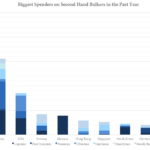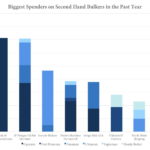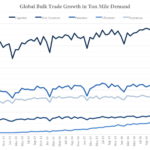New tonnage is likely to absorb most of the expected growth in the bulker market. Change could come from the unfolding trade war between the U.S. and China
The bulk market is currently showing signs of improvement but looking ahead into 2019, Peter Sand, BIMCO’s chief shipping analyst[ds_preview], does not expect any upside or downside at all. »The inflow of new ships will take care of the increased demand in 2019, so owners and operators should focus really hard on the recovery in 2018 and 2019,« he tells HANSA. The best recipe would be slow steaming in order to make the most of the increase in demand. This goes for all segments and all markets. »Owners should predominantly pay attention to the cost side of their businesses because they are all at the mercy of the overall global competitive market. This goes for OPEX, CAPEX and the voyage related costs where bunker is a big part. The optimal ship speed in the market is unlikely to be full steam ahead.«
Sand does not see an imminent large scale shift in trade lanes but this situation might still change: »The trade war that we see developing right now between the U.S. and China could actually bring about quite some changes to trade lanes, predominantly for soybeans, as it seems right now.« According to BIMCO, anecdotal evidence of fewer US gulf cargoes heading for China is an indicator of this. Changes in pricing of soybeans is another effect already seen. Trade lanes will be affected if Chinese buyers shy away their suppliers because of the extra cost from the proposed tariff on U.S. soybeans. Due to the displaced seasonality of brazilian and U.S. exports, the full effect is still to show. Brazilian exports take place throughout the year, but 80% of it is shipped in Panamax and Supramax ships during the months of April through to September. This is an exact opposite to the US exporters who ship 80% from November through March.
But it a fact that China needs the amount of soybeans being imported right now, to al large extent for feeding poultry, pigs and fish. »If they are not going to take it from the U.S., they have to source it from somewhere else. We see Brazil capable of stepping in perhaps for half of the volumes that may be required but we see no alternative enabling China to completely squeeze out US-soybeans. That is the positive that we need to remember in dry bulk: China needs the soybean.«
In 2017, the dry bulk shipping industry transported 51mill. t of soya beans at an approximate distance of 11,000 nautical miles from Brazil to China. During the same year, the U.S. exported 33mill. t, as it lost a bit of its share in the Chinese market. Brazil as an alternative might bring a certain distance upside. Some in the industry fear that Chinese importers may cut back on imports and live off their stocks for a while, which could significantly increase pressure on spot rates.
Besides soybeans, the new US tariffs on Chinese steel and aluminium products will likely not have a direct and large scale effect on most international bulker trades. Volumes between China and the U.S. are not that big. But the sailing distance is quite long. So, taking these out of business would negatively affect the overall market. Moreover, experts are afraid of these tariffs to be just the starting point for something bigger that might concern all markets, including container shipping.
Swing factor coal
On the iron ore side, Sand expects to see a continuation of the shift away from domestically mined ore in China. The country is improving the environmental footprint by using imported raw material of high quality. »This trend showed already in 2016 and especially last year. This benefits shipping and that is actually where we see the most upside, in iron ore going into China.«
In 2017 iron ore imports by ship grew by 4.7% to 1.054 bn t. Those imports account for 98% of all iron ore going into China. The bulker industry especially profits from Brazilian exports to China because of the long distance.
Chinese coal imports by ship have as well supported the dry bulk segment. They grew by 12% to 228.5mill. t.
Coal is likely to remain a swing factor in the market, simply because the country still produces a lot of it, the predominant part of which they consume themselves. Depending on how the Chinese set their standards in terms of ash content and calorific value of imported coal this might have an effect on imports. »China’s environmental efforts are an on-going issue as we hear from the Chinese leadership, but as a trend it is hard to nail down right now. As said, it remains the key swing factor, the Chinese are good merchants, if the price is right, they will source coal internationally,« says Sand who for 2018 only expects little upside from coal trades into China.
The capacity issues seem to remain unchanged for a while. Lately, Chinese owners have been buying a lot of second hand tonnage as they were expecting new age restrictions on the age of imported vessels from the Chinese government. But even if the Chinese drop out as buyers of old tonnage, these ships will remain in service. »It would be naïve to expect this to bring up scrapping activity. We are likely to see ships of a certain age go into different trades where they still have a value. If we look at the oil tanker market were we have an age restriction of 15 years for trading for oil majors, we see plenty of old ships around and we see VLCCs getting scrapped at the age of 20, 21, 22,« says Sand.
It remains to be seen what the effect of the IMO’s new climate targets for the shipping industry will bring about.






















